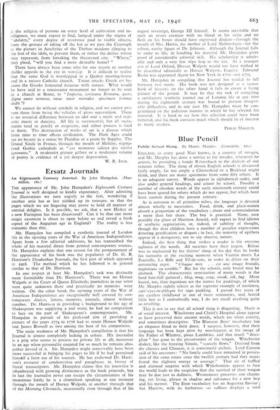Idolatry
Holy Images. By Edwyn Bevan. (Allen and Unwin. 7S. 6d.) Now that the Hebraic Christianity of the Puritans, which derived its inspiration almost as much from the Old as from the New Testament, is practically extinct, most of us would read with sympathy the dignified remonstrances of Dion Chrysostom and Maximus of Tyre against the prejudice which even in their time condemned all pictorial and plastic representations of the gods, a prejudice which was to contribute to the destruction of the supreme achievements of artistic genius. We are indignant when we see the defacement of mediaeval masterpieces in our own country by the misguided zealots of the sixteenth and seven- teenth centuries. What, we ask, can be more barbarous than to suppose that to symbolise the majesty of the Divine in the form of the noblest of God's creatures is mere fetishism, the worship of inanimate blocks of wood and stone? Such a notion, we think, can have arisen only in a nation too materialistic to know that poetry and art are the natural -language of devotion.
Dr. Bevan has discussed the problem impartially, and has shown that iconoclasm has, after all, something to say for itself. Dislike of art in the service of religion has taken several forms. The typical Jewish attitude was mere contempt for the wor- shippers of idols, who adored the work of their own hands; there was no spiritual power whatever residing in these images.
Nevertheless, the Hebrews were not consistent in taking the Second Commandment in its literal sense. Moses was bidden to make images of Cherubim for the Tabernacle; David kept Teraphim in his house; and so strong was the mana which emanated from the Ark that Uzziah was promptly electrocuted when he touched it. There was also a feeling that it was impious to represent the Deity in the form of a man. In the Western Church this objection was got over both on the ground that in Daniel God is represented as "the Ancient of days," i.e., as an old man, and on the ground that no Christian could be so ignorant as to suppose that a picture of an old man was intended to be a portrait of God. The Eastern scruple against representing figures in the round, though no objection was taken to pictures, is not easy to understand. The test was whether you could pinch the nose of the figure ; if you could, it was unlawful. The Platonic objection to art as a copy of a copy was sometimes urged. The ancient world had to wait for Philostratus to teach that "imagination," which "copies what it has not seen," is a higher faculty than "imitation." Synagogues after the Christian era contain pictorial representations, and the Moslems no longer keep their rule against them.
The Christians, however, could not kill idolatry by ridicule, for they believed that, in the words of Tatian, "evil spirits hide themselves in the statues and consecrated images." Some images had even wrought miracles, the work, of course, of the demons who inhabited them. St. Paul curiously wavers between the two opinions. "An idol is nothing in the world "; but "I would not that ye should have communion with devils."
Dr. Bevan shows that sympathetic magic and fetishism went farther in the Eastern than in the Western Churches. The iconoclasts, who according to some represented a Semitic revolt within Christianity, had some excuse for their vandalism, as some have found excuses for the English Puritans.
We need not follow the author into the tedious niceties of adoratio and veneratio. It is enough to say that as Christianity is the religion of persons on every level of cultivation and in- telligence, we must expect to find, lumped under the stigma of " idolatry," every degree of reverence paid to visible objects, from the gesture of taking off the hat as we pass the Cenotaph TO the picture in Aeschylus of the Theban maidens clinging to the feet of the idols, to prevent them, or rather the deities whom they represent, from forsaking the threatened city. "Where," they plead, "will you find a more desirable home? "
There have always been some who for one reason or another dislike appeals to the eye in worship. It is difficult to realise that the same God is worshipped in a Quaker meeting-house and in a rococo Catholic church. Tatian attacks. Greek art be- cause the Greeks honoured hetaerae with statues. What would he have said to a renaissance monument no longer to be seen in a church at Rome, to " Imperia, cortisana Romana, quae, digna tanto nomine, rarae inter mortales specimen formae dedit"?
We cannot do without symbols in religion, and we cannot pre- vent them from being the vehicles of gross superstition. There is no essential difference between an idol and a myth and orgi- astic music or dancing. All life is sacramental; but all sacra- ments tend to petrify or evaporate, and either process is fatal to them. The destruction of works of art is a disease which from time to time affects civilisation. The Dark Ages could see no beauty in a statue by Pheidias or a poem by Sappho. The Grand Siècle in France, through the mouth of Moliere, stigma- tised Gothic cathedrals as " ces monstres odieux des siecles ignorants." A modernist picture gallery or a modernist volume of poetry is evidence of a yet deeper depravation.
W. R. INGE.































 Previous page
Previous page